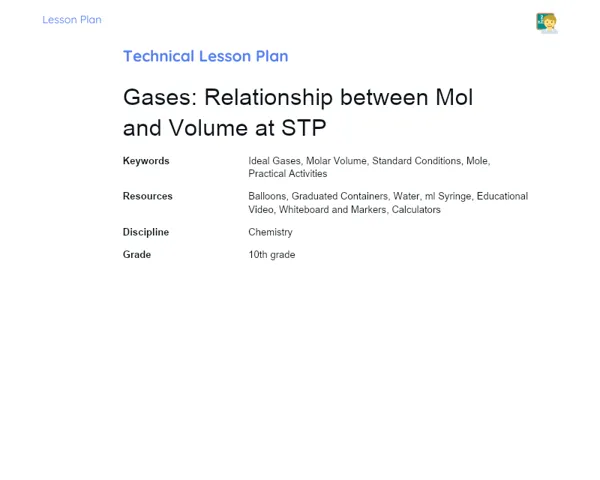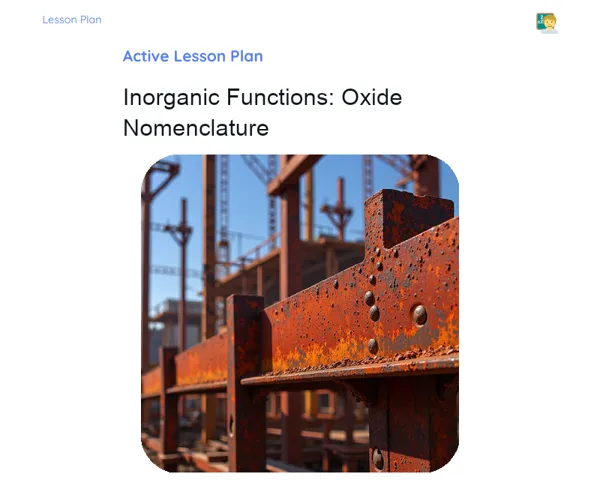Lesson Plan | Lesson Plan Tradisional | Equilibrium: Partial Pressures
| Keywords | Chemical Equilibrium, Partial Pressures, Equilibrium Constant (Kp), Molar Concentrations (Kc), Relationship Kp and Kc, Practical Examples, Problem Solving, Haber-Bosch Process, Human Respiration, Δn (Mole Variation), Temperature (T), Gas Constant (R) |
| Resources | Whiteboard or chalkboard, Markers or chalk, Multimedia projector (optional), Slides or explanatory transparencies, Scientific calculators, Notebooks and pens for note-taking, Printed copies of practical exercises, Gas constant table (R), Periodic table (for reference) |
Objectives
Duration: 10 - 15 minutes
This stage aims to create a robust foundation for students to grasp the concept of the equilibrium constant based on partial pressures and its connection to molar concentrations. This understanding will help them follow further explanations effectively and engage more actively in problem-solving activities led by the teacher.
Objectives Utama:
1. Describe the equilibrium constant with regard to partial pressures (Kp).
2. Explore the link between Kp and the equilibrium constant represented by molar concentrations (Kc).
3. Provide practical examples to enhance students' comprehension.
Introduction
Duration: 10 - 15 minutes
This stage endeavors to lay a solid groundwork for students, allowing them to comprehend the concept of equilibrium constant based on partial pressures and its interplay with molar concentrations. This will help them follow subsequent explanations better and engage actively in guided problem-solving.
Did you know?
A fascinating fact about the equilibrium of partial pressures is its role in human respiration. In our lungs, gas exchange between blood and alveolar air relies on the differences in the partial pressures of oxygen and carbon dioxide. This understanding is essential for fields such as medicine and physiology, highlighting the critical relevance of grasping gas equilibria.
Contextualization
To kick off the lesson on Equilibrium: Partial Pressures, it’s crucial to introduce students to the significance of chemical equilibria in both daily life and industry. Many natural and industrial processes hinge on chemical equilibrium. For example, the production of ammonia through the Haber-Bosch process, which is vital for fertilizer manufacturing, serves as a clear illustration of an equilibrium reaction involving gases. Stress the importance of understanding how the partial pressures of gases affect equilibrium, as this knowledge is key to optimizing such processes.
Concepts
Duration: 50 - 60 minutes
This stage aims to deepen students' understanding of equilibrium constants in terms of partial pressures and molar concentrations. Through thorough explanations and practical examples, students will be able to apply the learned concepts to specific problems, thereby enhancing their grasp of the content and preparing for upcoming assessments.
Relevant Topics
1. Concept of Equilibrium Constant in Terms of Partial Pressures (Kp): Clarify that the equilibrium constant for gaseous reactions can be articulated by the partial pressures of the reactants and products. Utilize the general formula for Kp and provide clear examples of chemical reactions to illustrate this point.
2. Relationship between Kp and Kc: Elaborate on the formula that relates the equilibrium constants Kp (partial pressures) with Kc (molar concentrations). The formula is Kp = Kc(RT)^(Δn), where Δn represents the difference in the number of gas moles between products and reactants, R is the gas constant, and T is the temperature in Kelvin. Carefully explain each component of the equation and how they impact the relationship between Kp and Kc.
3. Practical Examples and Problem Solving: Offer hands-on examples for calculating Kp and Kc across assorted chemical reactions. Engage students in a step-by-step resolution of problems to assist them in applying the concepts discussed. Ensure students take note of key steps and the formulas utilized.
To Reinforce Learning
1. For the reaction N2(g) + 3H2(g) ⇌ 2NH3(g) at 500K, the equilibrium constant Kc is 0.040. Calculate Kp for this reaction.
2. In the reaction 2NO2(g) ⇌ N2O4(g), where Kp is 0.113 at 298K, determine Kc.
3. For a generic reaction with Kc equal to 5.00 at 400K, if the equation is 2A(g) ⇌ B(g) + C(g), calculate Kp.
Feedback
Duration: 20 - 25 minutes
This stage aims to affirm that students have comprehended the explanations and calculations conducted during the lesson. The detailed examination of the questions allows for a review of concepts, correction of any misconceptions, and clarification of doubts. Encouraging student engagement through reflective questions fosters a deeper and more practical understanding of the content and better equips them for future assessments.
Diskusi Concepts
1. ▶️ Question 1: For the reaction N₂(g) + 3H₂(g) ⇌ 2NH₃(g) at 500K, where Kc equals 0.040, compute Kp.
Explanation: Identify the given data: Kc = 0.040, T = 500K, R = 0.0821 (gas constant). Determine Δn (change in the number of gas moles): Δn = (2) - (1 + 3) = 2 - 4 = -2. Apply the formula Kp = Kc (RT)^(Δn):
Kp = 0.040 * (0.0821 * 500)^(-2)
Calculate (0.0821 * 500)^(-2):
(0.0821 * 500) = 41.05
41.05^(-2) = 1 / (41.05^2) ≈ 0.000594 Substitute into the formula:
Kp = 0.040 * 0.000594 ≈ 0.0000238 Conclusion: Kp ≈ 2.38 x 10⁻⁵.
Note: Ensure students pay attention to all steps and comprehend each stage of the calculation. 2. ▶️ Question 2: Given the reaction 2NO₂(g) ⇌ N₂O₄(g), where Kp is 0.113 at 298K. How do we determine Kc for this reaction?
Explanation: Identify the provided data: Kp = 0.113, T = 298K, R = 0.0821. Estimate Δn: Δn = (1) - (2) = -1. Utilize the formula Kp = Kc (RT)^(Δn) and rearrange it to find Kc:
Kc = Kp / (RT)^(Δn) Calculate (RT)^(-1):
(0.0821 * 298) = 24.4758
24.4758^(-1) = 1 / 24.4758 ≈ 0.0409 Substituting into the formula yields:
Kc = 0.113 / 0.0409 ≈ 2.76 Conclusion: Kc ≈ 2.76.
Note: Ensure students grasp the reversal of the formula and the reasoning behind the calculation of (RT)^(-1). 3. ▶️ Question 3: A general reaction has Kc equal to 5.00 at 400K. If the reaction is stated as 2A(g) ⇌ B(g) + C(g), calculate Kp.
Explanation: Identify the provided information: Kc = 5.00, T = 400K, R = 0.0821. Calculate Δn: Δn = (1 + 1) - (2) = 2 - 2 = 0. Utilizing the formula Kp = Kc (RT)^(Δn):
Kp = 5.00 * (0.0821 * 400)^(0) Identify (RT)^(0):
Any number raised to zero equals 1. Substituting into the formula:
Kp = 5.00 * 1 = 5.00 Conclusion: Kp = 5.00.
Note: Emphasize that when Δn is zero, the equation simplifies, as (RT)^(0) is equal to 1.
Engaging Students
1. 🎓 Question 1: Why is it essential to differentiate between Kp and Kc when studying gas equilibria? 2. 🎓 Question 2: How does temperature impact the relationship between Kp and Kc? Provide relevant examples. 3. 🎓 Question 3: In what real-world scenarios, whether industrial or natural, is understanding Kp and Kc vital? 4. 🎓 Question 4: Reflect on how variations in the number of gas moles (Δn) influence the relationship between Kp and Kc. 5. 🎓 Question 5: If the gas constant R were to change, how would this impact the calculations for Kp and Kc?
Conclusion
Duration: 10 - 15 minutes
This stage aims to recap the main concepts addressed throughout the lesson, reinforcing learning and ensuring that students achieve a thorough understanding of the content. The conclusion also correlates theory with practice, stressing the relevance of the topic and motivating students to appreciate the knowledge gained.
Summary
['Concept of equilibrium constant regarding partial pressures (Kp).', 'Connection between Kp and the equilibrium constant defined by molar concentrations (Kc).', 'Formula Kp = Kc(RT)^(Δn) and detailed explanation of each term.', 'Hands-on examples of Kp and Kc calculations.', 'Step-by-step approach to problem-solving.']
Connection
The lesson linked theory with practice by presenting real-world instances from industrial procedures and biological systems, such as the Haber-Bosch process and human respiration. The step-by-step problem-solving encouraged students to connect theoretical concepts to practical calculations, enhancing their understanding of Kp and Kc.
Theme Relevance
Grasping the equilibrium constants Kp and Kc is essential for numerous applications in everyday life. For instance, in the chemical industry, optimizing reactions like ammonia production can enhance efficiency and diminish costs. In the medical field, understanding gas equilibria in the lungs is critical for respiratory therapies. This knowledge underscores the practical significance and relevance of gas equilibria.



